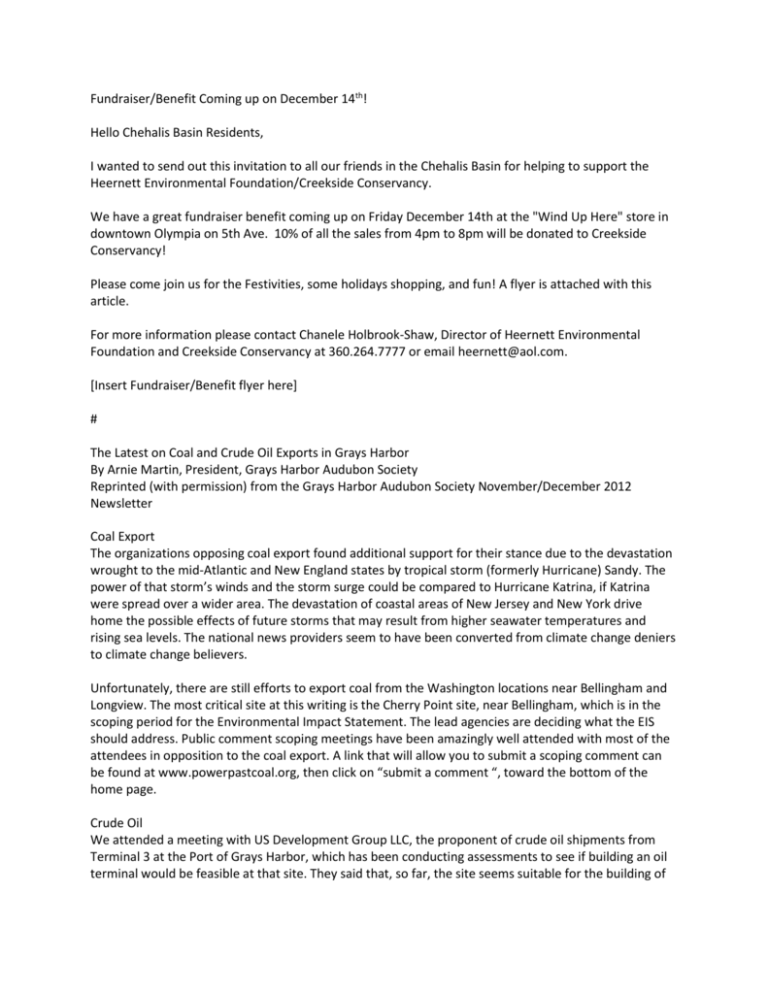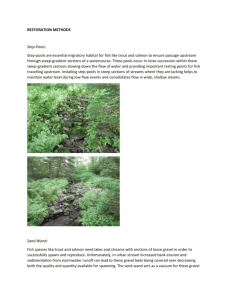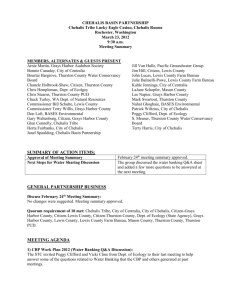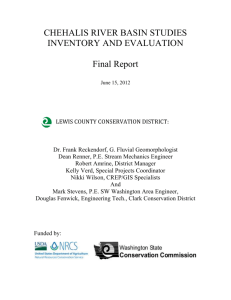December 2012 – All articles
advertisement

Fundraiser/Benefit Coming up on December 14th! Hello Chehalis Basin Residents, I wanted to send out this invitation to all our friends in the Chehalis Basin for helping to support the Heernett Environmental Foundation/Creekside Conservancy. We have a great fundraiser benefit coming up on Friday December 14th at the "Wind Up Here" store in downtown Olympia on 5th Ave. 10% of all the sales from 4pm to 8pm will be donated to Creekside Conservancy! Please come join us for the Festivities, some holidays shopping, and fun! A flyer is attached with this article. For more information please contact Chanele Holbrook-Shaw, Director of Heernett Environmental Foundation and Creekside Conservancy at 360.264.7777 or email heernett@aol.com. [Insert Fundraiser/Benefit flyer here] # The Latest on Coal and Crude Oil Exports in Grays Harbor By Arnie Martin, President, Grays Harbor Audubon Society Reprinted (with permission) from the Grays Harbor Audubon Society November/December 2012 Newsletter Coal Export The organizations opposing coal export found additional support for their stance due to the devastation wrought to the mid-Atlantic and New England states by tropical storm (formerly Hurricane) Sandy. The power of that storm’s winds and the storm surge could be compared to Hurricane Katrina, if Katrina were spread over a wider area. The devastation of coastal areas of New Jersey and New York drive home the possible effects of future storms that may result from higher seawater temperatures and rising sea levels. The national news providers seem to have been converted from climate change deniers to climate change believers. Unfortunately, there are still efforts to export coal from the Washington locations near Bellingham and Longview. The most critical site at this writing is the Cherry Point site, near Bellingham, which is in the scoping period for the Environmental Impact Statement. The lead agencies are deciding what the EIS should address. Public comment scoping meetings have been amazingly well attended with most of the attendees in opposition to the coal export. A link that will allow you to submit a scoping comment can be found at www.powerpastcoal.org, then click on “submit a comment “, toward the bottom of the home page. Crude Oil We attended a meeting with US Development Group LLC, the proponent of crude oil shipments from Terminal 3 at the Port of Grays Harbor, which has been conducting assessments to see if building an oil terminal would be feasible at that site. They said that, so far, the site seems suitable for the building of tank car unloading stations and storage tanks. Similar statements were made during the Port Commissioner’s meeting. The US Development Group representative, Kevin LaBorne, stated that the oil shipping terminal would ultimately bring two unit trains per day into their facility, each consisting of up to 120 tank cars of 650 barrel capacity (defined as 42 gallons/barrel for oil usage). This means that they could be transferring 156,000 barrels per day to their storage tanks, which are likely to hold 800,000 to 1,000,000 barrels of crude oil. This would give them the capacity to fill a 50,000 ton Panamax class crude oil tanker every 2.5 days. The crude oil would come from the Bakken formation in North Dakota, the Niobrara formation in Colorado/Nebraska, or from sites in Alberta, including tar sands oil that has been diluted to allow it to flow (synthetic crude). The oil shipments may be sent to West coast refineries in California or at Ferndale, but may also be shipped across the Pacific Ocean to Asian refineries. Many questions were asked of Mr. LaBorne during the meeting, with most relating to oil spill response and rail system capacity. If you remember, the Powder River coal shipments were to require one unit train per day, and the oil shipments plan to have two unit trains per day. This would make congestion of the Puget Sound and Pacific Rail Road (PSAP) link from Centralia to Hoquiam worse. There currently are unit trains loaded with soybean products (AGP receives a unit train about every 1.5 days) and Chrysler cars (about one train every 5 days). This traffic means that occasionally there might be a day with 4 unit trains arriving and another 2 or 3 unit trains departing. Thiscould be a logistical puzzle, trying to keep from overloading the Port’s RR yard or blocking the train traffic to and from the oil terminal. The capacity of the PSAP is limited by the traffic maximum speed (25 mph between towns and 10 mph in town). The current predominantly single-track with one passing track configuration of the PSAP only allows one arriving train and one departing train on the tracks at a time, over the 48 mile length. Even assuming that the PSAP runs trains 24 hours per day, there is only capacity for around 6 trains inbound and 6 outbound, allowing for speed reductions in Elma, Aberdeen and Hoquiam. The potential for rail crossing interference is raised to new levels, and the necessity for installing additional passing tracks (long sidings) is also raised. Concerns were voiced about the potential for oil spills due to derailments along the PSAP tracks, especially over the many bridges that cross tributaries of the Chehalis River. The rail cars are single-wall construction on the sides, giving the possibility of slicing the wall of a tank car open during even a low speed derailment. Questions were raised regarding the safety of the large oil storage tanks in the event of a tsunami, and/or a subduction-zone earthquake. The integrity of the storage tanks during a great earthquake and the ability of the containment berms to hold the tanks’ contents was also questioned. The timetable given for beginning construction of the facility was stated to be about 1 year from the decision to proceed with initial operation around one year after that. There were many questions regarding the permitting agency (City of Hoquiam), what other governmental agencies might be involved in permitting, and what precautions would be required to assure safety of the oil transport ships or barges during their passages in and out of the harbor and along our shores. The number of permanent jobs created from this terminal was stated to be 35 to 50, with their skill level comparable to that of someone employed in skilled labor in a pulp or paper mill. # Chehalis Fisheries Restoration Program by Miranda Plumb, USFWS, Lacey, WA A Brief History The Chehalis Fisheries Restoration Program (CFRP) is a long-standing restoration program in the largest watershed in western Washington. In the 1980s, Congress recognized that significant runs of salmon, steelhead, and cutthroat trout were declining throughout the Chehalis River Basin and commercial and sport fishing had been greatly diminished in the area. The Chehalis River Basin supports 31 natural populations of Pacific salmon and steelhead, and other important non-game fish like the Olympic mudminnow. The CFRP works toward the recovery of Chehalis River Basin fisheries by forming partnerships with private landowners, non-profit organizations, and local, tribal, and State agencies, and by implementing habitat restoration, habitat assessment, and public education projects. [Insert CFRP Photo 1 here] In the early years of the CFRP, many projects worked to repair damaged habitat near streambanks. Livestock exclusion fencing made up almost ¼ of all the projects implemented. These projects fenced off sections of the river and created a buffer zone where livestock couldn’t access so the vegetation would have a chance to rebound. Fencing projects most often included re-planting of riparian areas that had been eaten or trampled by livestock. Fencing projects allow riparian plants to reestablish along streambanks, which provide shade and cover for Pacific salmon and other fish and aquatic organisms. Riparian vegetation also provides habitat for wildlife, assists with streambank stability, and protects water quality. [Insert CRFP Photo 2 here] The CFRP supports and implements fish passage barrier removal projects. Culverts are typically the culprits. Fish passage barriers can be created if the culvert outlet is too high and fish are not able to jump up to the culvert. If the culvert is too small for the stream, it can be a water velocity barrier for fish and other aquatic organisms when water velocity exceeds their swimming capability. The CFRP works with many partner organizations to open up streams to allow fish, and other aquatic organisms, access to high quality habitat for rearing and spawning. Nearly 30% of all projects supported by the CFRP over the last 18 years increased stream connectivity by removing barriers. During the last decade, over 125 stream miles of salmon habitat were opened. Fish passage projects often incorporate large wood to the project, which adds structure and cover for juvenile fish. These projects often also involve stream-side plantings to provide shade and cover to help keep stream temperatures cooler and more optimal for fish and other stream creatures. [Insert CRFP Photo 3 here] [Insert CRFP Photo 4 here] About the author: Miranda Plumb is a biologist for the USFWS. She works with local landowners, Conservation Districts, counties, and State agencies on fisheries habitat restoration projects in the Chehalis River watershed. Please contact her with questions or project ideas at Miranda_Plumb@fws.gov or 360-753-9560. # Salmon Habitat Projects Proposed for 2012 Salmon Recovery Grants By John Kliem, Creative Community Solutions The Chehalis Basin Lead Entity will request nearly $750,000 from the Salmon Recovery Funding Board grant program to help fund two salmon habitat restoration projects and one acquisition project starting in 2013. These projects will restore and acquire riparian corridor along the Chehalis River and Scatter Creek, study juvenile fish usage in the Grays Harbor Estuary, and restore fish passage in Chenois Creek. The total estimated cost for all three projects will be roughly $1 million. Each year lead entities in the State of Washington submit a Habitat Project List to the Salmon Recovery Funding Board (SRFB) under the Salmon Recovery Grant Program. This program established by the Washington State Legislature in 1999 has contributed funding to over 60 salmon habitat projects throughout the Chehalis River Basin. These grant funds help cover costs for salmon habitat acquisition, restoration, assessment, design, and inventory projects. The grant program requires a local match. The three projects selected by the Chehalis Basin Lead Entity for funding beginning in 2013 include the Wein’s Farm Riparian Acquisition and Restoration Project, the Grays Harbor Juvenile Fish Use Assessment, and the Chenois Creek County Road Fish Barrier Culvert Correction. The Wein’s Farm project sponsored by the Heernett Environmental Foundation involves the purchase of 50 acres of land along the Chehalis River, Scatter Creek, and two small tributaries. This acquisition will preserve and restore important habitat for Chinook, coho, chum, cutthroat, and steelhead. In addition, an unusual element of this project includes the purchase of water rights to 60-acre feet of surface water and 40-acre feet of ground water. The project sponsor intends to withdraw the use of these water rights, which will contribute to instream flows especially during low flows during the summer months. The Wild Fish Conservancy received a third year of funding to continue their study that examines how juvenile salmon rely on the Grays Harbor Estuary nearshore habitats. The study will collect data on the type of species found, their abundance, use, and distribution within the estuary. The Wild Fish Conservancy will continue to publish annual reports about their findings. You can learn more about this multi-year project under their Projects page at www.wildfishconservancy.org. [Insert Salmon Habitat Photo 1, 2, 3 here] The third project funded was the Chenois Creek Barrier Correction project sponsored by the Chehalis Basin Fisheries Task Force. The Task Force will use the funding to replace a fish barrier culvert on Chenois Creek, a tributary to the Grays Harbor Estuary, with a 24-foot span bottomless arch culvert. The removal of this fish barrier will open up 6½ miles of excellent spawning and rearing habitat for Chinook, coho, chum, cutthroat, and steelhead. The SRFB will be making its final decision to fund these projects at their December 2012 meeting. Although the amount of grant funding is limited annually, the Lead Entity has submitted two alternate projects in the event surplus funds become available. These projects include restoring a section of Allen Creek, in Thurston County, and removing five fish barrier culverts on Campbell Slough in Grays Harbor County. The Chehalis Basin Lead Entity encourages those governments, organizations, and businesses within the watershed who are interested in sponsoring a salmon habitat project under the Salmon Recovery Grant Program to check out our website at www.co.grays-harbor.wa.us/info/pub_svcs/Lead_Entity/index.html for more information. ##







